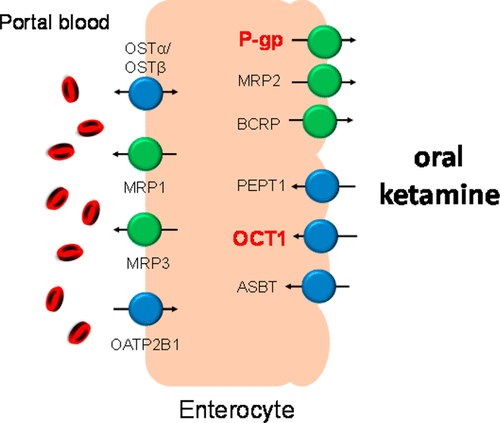当前位置:
X-MOL 学术
›
Mol. Pharmaceutics
›
论文详情
Our official English website, www.x-mol.net, welcomes your feedback! (Note: you will need to create a separate account there.)
Affinity of Ketamine to Clinically Relevant Transporters
Molecular Pharmaceutics ( IF 4.9 ) Pub Date : 2017-12-08 00:00:00 , DOI: 10.1021/acs.molpharmaceut.7b00627 Markus Keiser 1 , Mahmoud Hasan 1 , Stefan Oswald 1
Molecular Pharmaceutics ( IF 4.9 ) Pub Date : 2017-12-08 00:00:00 , DOI: 10.1021/acs.molpharmaceut.7b00627 Markus Keiser 1 , Mahmoud Hasan 1 , Stefan Oswald 1
Affiliation

|
Ketamine is a widely used intravenous anesthetic drug that has also a pronounced analgesic effect. Moreover, one of its metabolites was very recently shown to possess antidepressant activity. Consequently, oral administration of ketamine may become of interest in the future. There is evidence from in vitro data, drug–drug interactions, and the physicochemical properties of the drug that ketamine may be a substrate of drug transporters. Thus, it was the aim of this study to investigate the affinity of ketamine to clinically relevant transporter proteins that are expected to affect its intestinal absorption, distribution, and excretion. Ketamine was shown to be significantly taken up in a time- and concentration-dependent manner by OCT1–3. The affinity to OCT transporters at pH 6.5 (Km ≈ 35–75 μM) was clearly higher than that at pH 7.4. In addition, ketamine permeability was markedly lower at pH 6.5 than at pH 7.4 in a parallel artificial membrane permeability assay (PAMPA). Ketamine showed a low but significant affinity to P-gp at pH 6.5. In contrast to this, we could not detect any transport of ketamine by MATE1/2K. In conclusion, ketamine is a substrate for OCT1–3 and P-gp but is not recognized by MATE1/2K. Considering that ketamine is a lipophilic base that mainly exists as a cationic moiety (>90%) in the intestinal lumen, we conclude that the OCT-mediated cellular uptake as well as P-gp efflux is expected to be only of relevance in the human intestine (i.e., in the case of oral drug administration), where OCT1, OCT3, and P-gp are stably expressed at the apical membrane. On the other side, P-gp is not expected to contribute significantly to tissue (brain) distribution or renal excretion of ketamine.
中文翻译:

氯胺酮对临床相关转运蛋白的亲和力
氯胺酮是一种广泛使用的静脉麻醉药,也具有明显的镇痛作用。此外,最近已证明其代谢产物之一具有抗抑郁活性。因此,将来氯胺酮的口服给药可能会引起人们的兴趣。从体外数据,药物与药物的相互作用以及药物的理化特性方面有证据表明,氯胺酮可能是药物转运蛋白的底物。因此,本研究的目的是研究氯胺酮与临床相关转运蛋白的亲和力,这些转运蛋白预计会影响其肠道吸收,分布和排泄。OCT1-3显示氯胺酮以时间和浓度依赖性方式被大量吸收。在pH 6.5(K m≈35–75μM)明显高于pH 7.4时的浓度。此外,在平行人工膜通透性测定(PAMPA)中,氯胺酮的通透性在pH 6.5时明显低于在pH 7.4。氯胺酮在pH 6.5时对P-gp的亲和力较低,但很明显。与此相反,我们无法检测到MATE1 / 2K对氯胺酮的任何转运。总之,氯胺酮是OCT1-3和P-gp的底物,但未被MATE1 / 2K识别。考虑到氯胺酮是一种亲脂性碱基,主要作为肠腔中的阳离子部分(> 90%)存在,我们得出结论,预计OCT介导的细胞摄取以及P-gp外排仅与人类有关OCT1,OCT3和P-gp在心尖膜稳定表达的肠道(即口服药物的情况)。另一方面,
更新日期:2017-12-08
中文翻译:

氯胺酮对临床相关转运蛋白的亲和力
氯胺酮是一种广泛使用的静脉麻醉药,也具有明显的镇痛作用。此外,最近已证明其代谢产物之一具有抗抑郁活性。因此,将来氯胺酮的口服给药可能会引起人们的兴趣。从体外数据,药物与药物的相互作用以及药物的理化特性方面有证据表明,氯胺酮可能是药物转运蛋白的底物。因此,本研究的目的是研究氯胺酮与临床相关转运蛋白的亲和力,这些转运蛋白预计会影响其肠道吸收,分布和排泄。OCT1-3显示氯胺酮以时间和浓度依赖性方式被大量吸收。在pH 6.5(K m≈35–75μM)明显高于pH 7.4时的浓度。此外,在平行人工膜通透性测定(PAMPA)中,氯胺酮的通透性在pH 6.5时明显低于在pH 7.4。氯胺酮在pH 6.5时对P-gp的亲和力较低,但很明显。与此相反,我们无法检测到MATE1 / 2K对氯胺酮的任何转运。总之,氯胺酮是OCT1-3和P-gp的底物,但未被MATE1 / 2K识别。考虑到氯胺酮是一种亲脂性碱基,主要作为肠腔中的阳离子部分(> 90%)存在,我们得出结论,预计OCT介导的细胞摄取以及P-gp外排仅与人类有关OCT1,OCT3和P-gp在心尖膜稳定表达的肠道(即口服药物的情况)。另一方面,



























 京公网安备 11010802027423号
京公网安备 11010802027423号